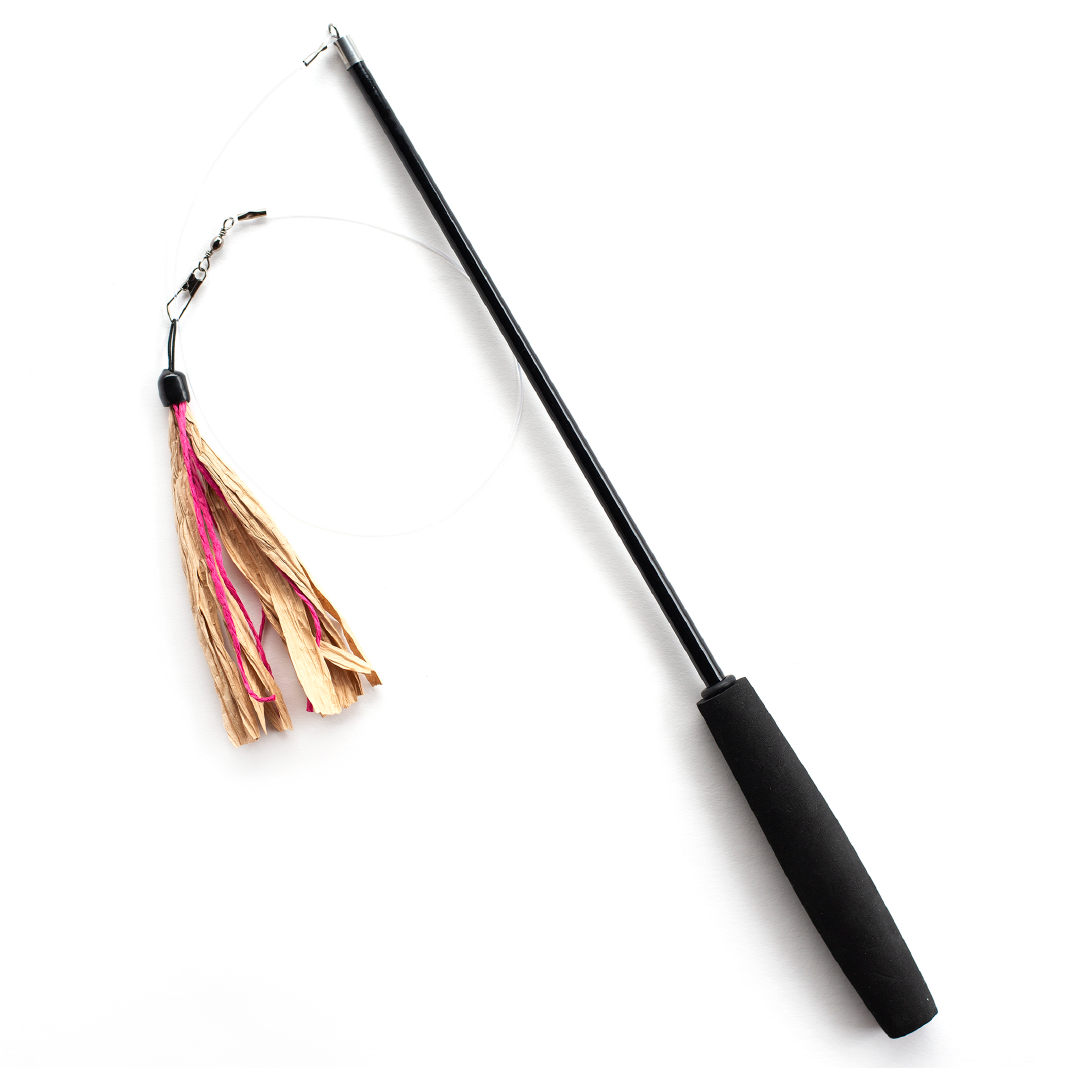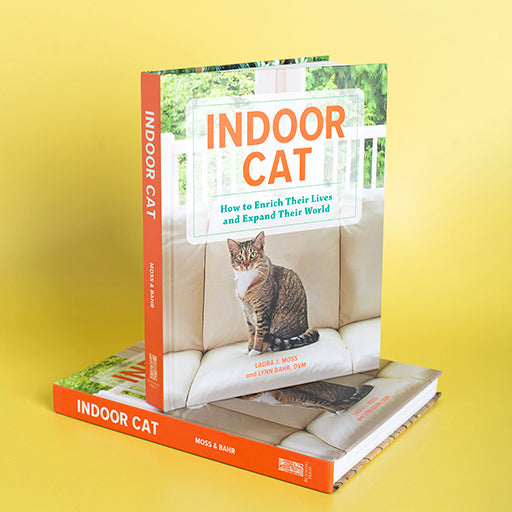4 Myths About Indoor Cats Debunked
“Cats are low-maintenance pets. All they do is sleep.”
We’ve all heard it. But cat lovers know just how much time and energy go into being the parent to an indoor cat. Each cat has a vibrant personality and unique needs that go beyond simple room and board.
I’ve known for decades that indoor cats need enrichment to live longer, happier lives, which is why I started Dezi & Roo. But I wanted to dig deeper into the way we live with and love our cats and to explore how we can make those lives better. So I partnered with Laura J. Moss, a journalist and founder of Adventure Cats to write a book about some very practical ways to enrich the life of your indoor cat.

We set out to help you understand your cat’s perspective and debunk some of the most common myths about indoor cats. Here’s a sneak peek at our findings.
Myth #1: Indoor cats live longer than outdoor cats
When it comes to indoor cats vs. outdoor cats, there is a clear winner in life expectancy. Indoor cats live longer on average than outdoor cats — most estimates put the average cat lifespan indoors at around 12-15 years; outdoors cats average 5-7.. But those are all-or-nothing figures. None of the published studies really addresses the lifespans of cats who are fully cared for, but enjoy the occasional outdoor adventure.
Should you let your cat go outside?
Veterinarians have been promoting the indoor-only lifestyle for the past couple of decades, but in reality, there is no evidence to suggest cats who enjoy some time outdoors, experience a significantly shorter life than exclusively indoor cats. In fact, the research shows that cats need mental and physical stimulation to live a long, happy life.
My advice? Allow your cat outdoors only if you can do so in a safe way.
For example, if you live on a busy street or in a large city, allowing your cat to roam free significantly increases their risk of getting injured or killed. So you might need to put in a bit more effort than just opening the back door. But with a bit of training, you may be able to take your cat out on a harness or in an enclosed stroller. Even an open window will give your cat a change of pace. For cats whose humans live in suburban or rural areas, a screened-in patio works great. Or if you’re crafty, build your feline bestie a catio. Installing catproof fending is another great option that is affordable and an effective way of keeping your cat safely enclosed in the backyard. The point is, let your cat get some fresh air and sunshine, but keep them safe.
Myth #2: Cats sleep all day

One of the signs of a happy indoor cat is an active, playful feline. If your cat is sleeping 20 hours a day and rarely plays, she’s probably bored.
How much sleep does my cat need?
Most cats sleep about 12 to 16 hours per day with their most active times at dawn and dusk. But instead of deep sleep, they tend to rest or doze. (That’s where we get the term “cat nap” from.) In the wild, cats need their down time to recuperate after hunting. Domesticated felines follow a similar cycle.
When your cat is awake, she wants to play and explore. That’s why she sometimes wakes you up at 3 a.m. But exploring isn’t much fun if you only ever see the same four walls day in and day out. Cats need variety in their indoor environments. From different scents to comfy bedding and a variety of toys, cats need the opportunity to exercise mind and body.
Myth #3: Cats can’t be trained
My co-author, Laura J. Moss, debunked this myth years ago when she founded Adventure Cats. Her site offers advice for everything from clicker training for cats to finding the best kind of cat harness.
How can I train my cat?
Cats have a reputation for being difficult to train. They're independent, stubborn and don't like to do anything they don't want to do. But each cat is different, and if you've ever had your cat come running to the sound of the can opener, you know your cat is smart enough to be trained.
The key is to use positive training methods that reward your cat for good behavior. Reward them with treats, petting and play sessions. They will quickly learn what behaviors get them what they want, and will continue to repeat those behaviors.
One of the most popular forms of cat training is clicker training. The idea behind this approach is that cats learn quickly when they associate the sound of a clicker with good things happening (like treats).

It’s a great solution if you and your cat have the patience, but there are so many other ways to help your cat respond to you. I recommend silver vine for cats who are reluctant to get in their carrier or get easily stressed on trips. It produces a euphoric responses and while it tends to stimulate your cat, it could keep them distracted enough to forget to be stressed.
Myth #4: Cats are low-maintenance pets
I’m going to let you in on a little secret: cats are not low-maintenance. In fact, indoor cats should be very high-maintenance. If you don’t think your cat is a focal point of your life, you’re probably not giving him enough attention.

How do I make time for my cat?
The short answer: play with them! Cats are social animals, and if you want them to be happy, you need to spend time with them.
It goes back to the idea of enrichment. Cats get bored just like we do, and it’s up to us to make sure they’re mentally stimulated. I recommend feeding their food in food puzzles or toys so they have to work for their meal and can eat at their own pace.
Playing with them regularly is also important for their mental health.Try different types of play — chase games, wand toys and play tunnels will do the trick. Also keep in mind that most cats don’t need to be walked outside (though if they are friendly toward other people and animals, they should go outside sometimes!), but they do need some human interaction every day to feel fulfilled.
Indoor vs. Outdoor cat
The long-held belief that an indoor cat has a better life than an outdoor cat isn’t based in fact. While it’s certainly true that indoor cats can live full lives, it’s not necessary to keep them inside 100 percent of the time. But if you choose to keep your cat inside your home for safety or health reasons, look for ways to enrich their environment like regular play time, scent enrichment, and food variety.
Cats are born with a natural instinct to hunt and explore. If you have an indoor cat, you can help satisfy that curiosity through regular playtime and by adding interactive toys to their environment. This can also help stave off boredom and related behavioral problems like anxiety or aggression.

Outdoor cats obviously face different challenges. In addition to potential injury from traffic and other hazards, they can contract infectious diseases and parasites like ticks and fleas. Regardless of your cat’s preferred environment, you’ll need regular vet check-ups to monitor their health.
Learn more about keeping your indoor cat happy and healthy
If you’d like to learn more about enriching the life of your indoor cat, pre-order Indoor Cat: How to Enrich Their Lives and Expand Their World (Running Press Adult, April 5, 2022) from your local bookseller. We include scientific studies, expert opinions and firsthand accounts of how to help your feline companion make the most out of life.
And be sure to check out the Dezi & Roo blog or Adventure Cats for more tips and tricks on helping your feline fur-iend live live to the fullest.
Share:
7 comments
-
I have had cats all of my long life, and would never keep them permanently indoors. Lifespan is one thing, but quality of life is another. A cat needs to be able to explore, hunt, and get stimulation from the outside world.
Most of my cats have lived well past 10 years, the oldest reaching 20. They will decide when they want to spend more time indoors as the age.
Our current cat, Marie, is 14 and spends most of her time in the house, with occasional trips into the garden. She has her own cat door, and can decide for herself. In my view, this is the right way to give a cat a full and fruitful existence.Jim on
-
I had two cats, sisters from the same litter, who spent much of their lives outdoors. I took them to the vet to be spayed, when they were young; thereafter, basically never. They seemed happy and healthy and happy the whole time (except at the end, when each was succumbing…). One lived to be almost 17 and the other made it past 19. I don’t know what this tells us but if I had it to do over again, I would take the same route. (I should mention that I live in a large, wooded condominium complex, large enough that cats can live long outdoor lives without much exposure to traffic. Also, most of their outdoor lives were lived at night, maybe 10 PM to 6 AM, meaning auto traffic would in any case be minimal.)
Rick on
-
Human prisoners usually have a longer life then those who have to survive without the protection of prison guards.
Bill Fargo on
-
I have to disagree with your comments on indoor vs outdoor cats. I am not sure where you are getting your information from. Most certainly outdoor cats lifespan is much less than indoor cats, even when they are well cared for. Harm comes in many ways now. In urban settings coyotes are ruling and very well fed with part-time outdoor kitties. Most outdoor kitties are not found or return home. Let’s think about it: indoor cats out for brief periods of time have very little skills at knowing how to protect selves (your comment that this is ok). If frightened they easily get confused and off they run to hide. Cats can travel very long distances in a terrified state. If one wants to take their kitties outside, it is recommended to do so on special harnesses (can’t wiggle out of- not the strap kind) and leashes or backpack carriers. Further Indoor cats can be stimulated in so many ways these days and they live to 15-20 years if well cared for with regular vet care. I help families try to find their lost kitties and I hear all the time that they only go out occasionally. We must remember our pets are like children who never grow up so they need our adult decision-making about safety including protection from outdoor harm. My cats have been indoor cats for 35+ years and only one with a genetic heart defect died before the age of 14 years. Most have lived 16 to 19 years. They are happy and loving and are very intelligent like my poodle dogs. This does require regular interaction on the part of the pet parent. Cheers!
Lisa on
-
I’ve moved and need to keep my cat s indoors however its been 7 months and they still haven’t settled. I’ve used plug ins cat nip toys and cat trees etc. I work from home so theyre not on their own but are not happy. Tried a harness but they hate it. Will this situation improve Im at my wits end 😱😱😱
Pat Davies on
-
Finally, You are the first to admit that the data on the lifespan of indoor cats with access to the outdoors is fuzzy at best. You see claims like “outdoor cats live 2-5 years where indoor cats live 15-20 years” or similar all over the internet with not source. Some PhD student who loves cats should do a study to see how access to the outdoors really effects lifespan. It feels like everyone has an agenda on this subject and distorts the facts.
Chris on









